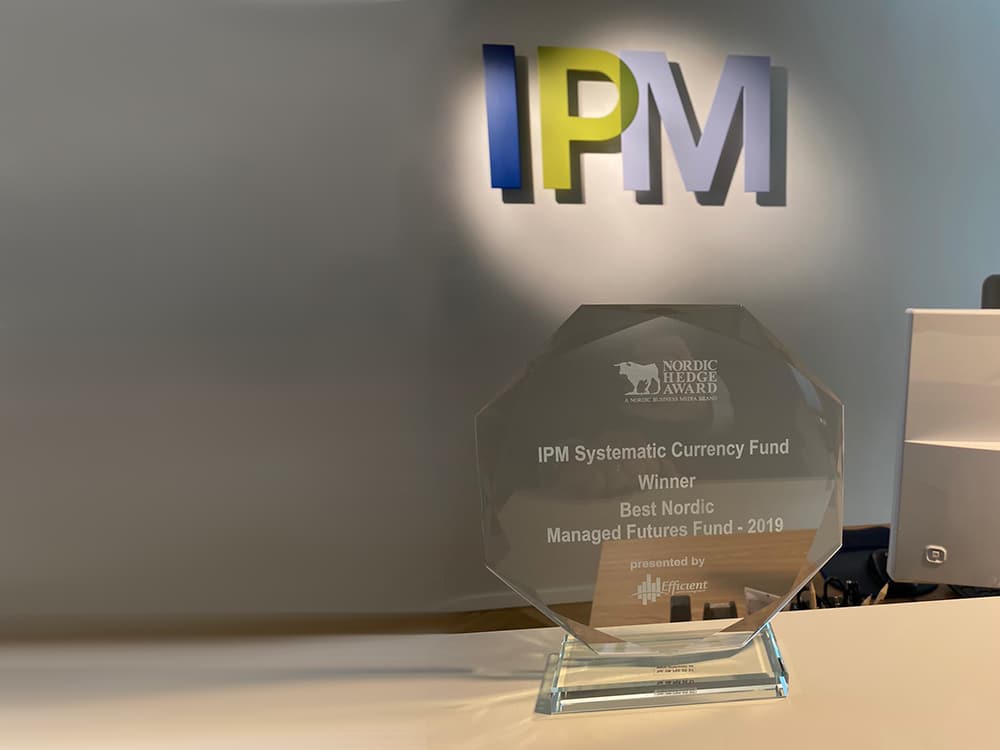Stockholm (HedgeNordic) – Nordic CTAs enjoyed a great run from the beginning of 2019 through the end of the summer, gaining 4.2 percent on average. However, the return to form in 2019 was short-lived, as the group of Nordic CTAs ended the year up 1.3 percent on average. After experiencing the worst year on record in 2018, Nordic CTAs did enjoy a relatively strong year in 2019.
In recognizing the best Nordic CTAs of 2019, the quantitative model co-developed with the Swedish House of Finance determined five names that stood out in 2019 and the previous three years. The following five funds competed for the three prizes in the “Best Nordic CTA” category:
Winner: IPM Systematic Currency Fund

The winner in the “Best Nordic CTA” award category is IPM Systematic Currency Fund, a vehicle that trades liquid instruments in developed and emerging market currencies based on proprietary investment models. The Systematic Currency strategy managed by Swedish systematic asset manager Informed Portfolio Management (IPM) was up 8.2 percent in 2019, following a gain of 3.4 percent in 2018.
The investment models employed by IPM Systematic Currency evaluate the relative attractiveness of financial instruments and aim to exploit the divergence in fundamentals by taking long and short positions. The dislocations identified by IPM’s proprietary models are typically medium to long term. In 2019, IPM Systematic Currency’s portfolio of developed market currencies contributed to 4.7 percent in gross returns, whereas the portfolio of emerging market currencies added 1.9 percent to gross performance. The directional portfolio, meanwhile, contributed a mere 0.4 percent in gross returns.
Second Place: Lynx (Sweden)
The trophy for second place goes to Swedish-domiciled systematic fund Lynx (Sweden), last year’s best performing Nordic CTA with a gain of 15.4 percent. “2019 was a very good year for CTAs, but even a better year for Lynx,” Svante Bergström, CEO and co-founder of Lynx Asset Management, said in an interview at the beginning of the year. “It was a fantastic year for us.”
Lynx (Sweden) relies on both trend-following models and diversifying models to catch trends in various markets and reduce drawdowns in non-trending environments. “Two-thirds of the profits came from trend-following models and the last third from our diversifying models,” explained Bergström. The fact that Lynx (Sweden) is “more heavily relying on non-trend models” represents one possible reason as for why the fund outperformed peers last year.
Digesting last year’s performance in more detail, Bergström said that “we had a huge trend in fixed income markets in the first eight months or so, where we made a lot of money on falling interest rates globally.” Lynx (Sweden) was up over 29 percent in the first months of 2019. “Then that trend turned around after the summer,” said Bergström, adding that “we had to give back some of the profits in the sector.”
Lynx (Sweden), the oldest running hedge fund in Sweden, will reach its 20th anniversary in May. “That is something to be proud of,” Bergström commented on the 20-year track record and on holding the title of the oldest running Swedish hedge fund. “We are proud of what we have, and we are looking forward to the next 20 years.”
Third Place: Shepherd Energy Portfolio

Shepherd Energy Portfolio, the winner of last year’s “Best Nordic CTA” award, took the third step on the podium this year. The futures-based trend-follower focused on the Nordic power markets delivered an annualized return of 5.5 percent over the past three years through the end of last year, despite ending 2019 in negative territory. 2018, on the other hand, was an exceptionally strong year for Shepherd Energy Portfolio.
“The trading year 2019 for Shepherd Energy Portfolio was a rather difficult one with a lot of sharp price movements in an overall sideways market, as well as high uncertainty regarding the price picture for continental power due to the Brexit issue and high volatility in the carbon emission rights,” portfolio managers Arne Österlind and Andreas Edlund said at the beginning of 2020. “The portfolio ended the year 2019 with a negative return of 0.26 percent, which is in great contrast to the successful year of 2018, when the portfolio earned almost 14 percent net return to investors,” they added.
Stockholm-based Shepherd started trading European gas in July of 2019, concentrating on spread and arbitrage trading in the gas market. “We ended the first six months up 7.5 percent with low volatility and negative correlation to the MSCI,” said Österlind and Edlund. Starting from mid-January of 2020, the strategy focused on the gas market is implemented in the main Shepherd Energy vehicle. “The gas trading is managed by Ben Ketley as head portfolio manager from Shepherd’s London branch office with the intention of strengthening the team with another expert gas and power trader going forward in 2020.”
The “Best Nordic CTA” award category was supported and presented by Efficient Capital.

